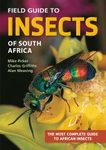![Forest Insects in Europe Forest Insects in Europe]()
Click to have a closer look
About this book
Contents
Customer reviews
Biography
Related titles
About this book
Read our interview with Beat Wermelinger.
Forest insects play important roles ecologically and economically. They pollinate plants, decompose dead plant and animal tissue, provide food for vertebrates, regulate pest organisms, and shape entire landscapes. Some are considered pests, while others provide usable products. Introduced species may become invasive, while the survival of others is threatened.
Forest Insects in Europe has been written not only with professional entomologists in mind, but also for nature lovers generally. The descriptions of the various roles insects play in forest ecosystems are intended to be easily comprehensible, but still scientific. Forest Insects in Europe is richly illustrated with attractive photos, and contains 580 fascinating colour images of over 300 different insect and spider species. The German edition was awarded the Prix Moulines by the Swiss Entomological Society in 2019.
Contents
Preface
1 Diversity and functions of insects
PART 1 ECOLOGICAL FUNCTIONS
2 Insects and plant reproduction
3 Turnover of green plant biomass
4 Decomposition of wood
5 Exploitation of animal waste
6 Maintaining soil fertility
7 Food for other organisms
8 Natural enemies
9 Antagonists of bark beetles
10 Ecological significance of red wood ants
11 Transport of organisms
12 Maintaining stand vitality
13 Shaping of ecosystems
PART 2 ECONOMIC SIGNIFICANCE
14 Economic damage
15 Insects and human health
16 Usable insect products
17 Introduced species
18 Endangered forest insects
Bibliography
Photo credits
Glossary
Species and subject index
Customer Reviews
Biography
Beat Wermelinger, Dr. sc. nat. ETH, biologist, Adliswil. Head of the research group. Forest entomology at the Federal Research Institute for Forests, Snow and Landscape (WSL), Birmensdorf. Research focus: bark beetles and natural enemies, Biodiversity, windthrow succession, climate change and neozoa. Lecturer at the Federal Technical University ETH Zurich and the Swiss Tree Care Federation.
By: Beat Wermelinger(Author)
351 pages, 572 colour photos, 4 colour illustrations, 3 tables
"I cannot wait to get my hands on this book! Aside from Wermelinger's very special conceptual approach, his excellent pictures are highly relevant for European forests (there are not many knowledgeable entomologists that also are keen photographers). Forest Insects in Europe will become a new standard for a holistic approach to forest insects. Highly topical in today's era of climatic shifts and insect outbreaks, the book brings originality and incites rethinking of one's involvement in forest ecosystem, even for a forestry-educated professional and specialist like myself. As well as being of interest to hobbyists and nature lovers, the book should be included as reading on entomological courses, especially at the university level."
– Boris Hrasovec, Ph.D., Full Professor, Faculty of Forestry, University of Zagreb, Croatia
"This book will make a nice addition to the libraries of any forestry professionals or amateur environmentalists who would like a well-illustrated compendium of insect roles in forests and how these affect human use of forests. It provides a focused and comprehensive treatment and is illustrated with outstanding photographs."
– Timothy D. Schowalter, Professor Emeritus, Entomology, Louisiana State University, Baton Rouge, LA, USA


































